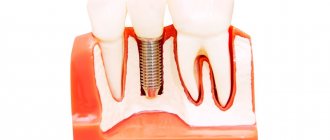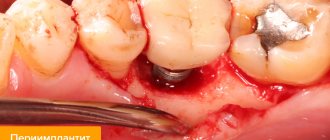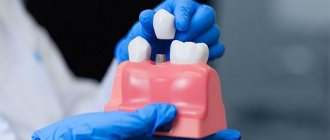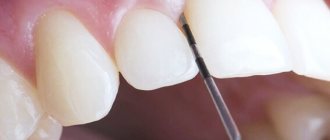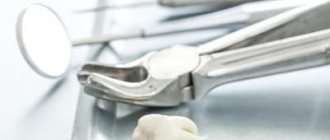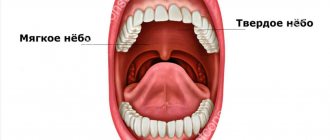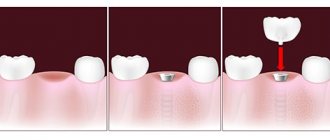With the development of implantation technology, more and more patients prefer this method of restoring lost teeth, as the most reliable, aesthetic and convenient. Set it and forget it! This is exactly what happens in most cases, unless the plans of the doctor and his patient are disrupted by the most formidable complication, due to which the implant can be lost - peri-implantitis. This is what visitors to numerous dental forums scare each other with, so much so that some give up the idea of installing an implant altogether. In this article, let's figure out what peri-implantitis is, how to avoid it, and, if necessary, treat it.
What is peri-implantitis?
Peri-implantitis is an inflammation of the tissues and bone surrounding the implant, which ultimately, without timely intensive treatment, leads to bone loss and loss of the implant.
Peri-implantitis is much easier to prevent than to stop a process that has already begun. The main cause of the disease is a bacterial infection, which can occur either at the moment of implantation, and then the symptoms of the disease appear a few days after the operation, or after some time - from several months to several years.
Doctor's advice - when is re-implantation possible?
After extracting the artificial root, a break is taken for 1-2 months. There is no need to wait any longer, otherwise jaw atrophy will begin. Reimplantation is combined with osteoplasty if there is enough bone and gum tissue in the implant area. Otherwise, after the hole has healed, bone augmentation is first carried out in a separate stage, and only then the implant is installed.
Levin Dmitry Valerievich
Chief physician, Ph.D.
Why does peri-implantitis occur?
According to statistics, during implantation, more than 95% of implants are successfully installed and take root. 5% of failures are associated with various reasons, but in approximately 1% of cases, peri-implantitis is “to blame” for the loss of the implant, i.e. inflammation affects approximately 1 artificial tooth root out of 100. You need to understand that complications are possible with any surgical intervention. It depends on the patient's health and immune system. If the patient has disorders or may have a decrease in immunity under the influence of unfavorable external factors, this must be taken into account. That is why implantation requires preliminary thorough diagnosis by the surgeon.
Other causes of implant infection and the development of peri-implantitis can be:
- Incorrect behavior of the patient himself after implantation:
- poor hygiene,
- violation of the treating dentist’s recommendations for the care of implants,
- increased chewing load, careless attitude towards your artificial teeth, gum injuries near the implant,
- smoking,
- ignoring routine examinations to monitor the condition of the implant roots.
- Mistakes made by specialists during implantation:
- an inappropriate prosthetic technique was chosen,
- the implant is placed in the wrong place,
- the implant is installed in a hole with a larger diameter than required,
- the load on the implant was incorrectly calculated,
- a complete diagnosis was not carried out and/or the patient’s health status was incorrectly assessed before implantation,
- During the operation, asepsis was violated.
- A low-quality implant was installed. This can happen due to the fault of the dentist or at the insistence of the patient himself.
- There was a source of infection in the patient's mouth - caries, periodontal disease, dental plaque and calculus. In order for implantation to proceed without complications, all sources of possible infection in the oral cavity must be eliminated at the preparation stage.
How is diagnostics carried out?
An x-ray is always performed as a diagnostic measure to confirm or exclude peri-implantitis. If the pathology is not detected (i.e., so far only mucositis), then the x-ray does not show a dark gap between the implant and the bone or loss of the latter. In the picture, the bone is gray, and the implant is almost white. When a darkened area is nevertheless detected (there is no bone in it), then this already speaks of peri-implantitis. Generally, the greater the length/width bone resorption near the implant, the more severe the stage.
Also, to identify the causative agent of inflammation, the patient may be prescribed a blood test or an oral smear. Additionally, probing is carried out - the tip of the probe is inserted into the gum pocket, so the dentist manually determines the depth of bone loss. Another diagnostic method is to measure the stability of the implant in the bone.
Read on the topic: how the strength of an implant installation is assessed - who does it and why it is needed.
Symptoms of peri-implantitis:
- The disease begins with redness, discomfort and swelling of the gums in the area of the installed implant.
- There is bleeding of the gums in the problem area.
- At the site of inflammation, connective tissue begins to grow.
- The gum moves away from the implant, as in periodontal diseases, and a periodontal pocket forms around the titanium rod.
- Serous fluid and pus may be released from the pocket, and a fistula may form.
- The X-ray image reveals a noticeable loss of bone tissue around the implant.
- The implant becomes loose, the patient feels its mobility, this provokes further destruction of the bone around the titanium rod.
- Ultimately, if the inflammatory process is not stopped, implant rejection occurs.
Differences between mucositis and peri-implantitis
It is worth highlighting such a pathology as mucositis - this is inflammation of only the gums around the prosthesis or bone tissue where the implant is placed. In this case, the bone does not become inflamed and does not sag, as with peri-implantitis. But the latter may well become a complication of mucositis if the treatment was untimely or of poor quality.
Symptoms of mucositis - the gum tissue becomes slightly swollen and changes color to red, bluish or even purple. In this case, the gums may peel off slightly from the prosthesis, and food gets clogged into the resulting gum pocket.
How is peri-implantitis treated?
The success of treatment for peri-implantitis depends on what stage of the disease it is started at: the earlier, the better the prognosis.
Treatment is aimed primarily at relieving inflammation in the area and restoring bone volume once it has begun to be lost. Therefore, there are 2 main stages in treatment - sanitation of the inflamed area and surgical bone augmentation.
- Before starting treatment, the doctor conducts a diagnosis. The main stage of such a diagnosis will be a 3D CT scan to accurately determine the affected area and the condition of the bone tissue.
- Then professional hygiene of the implant and adjacent areas is carried out - removal of soft dental deposits and tartar from the dental crown and from the subgingival space using ultrasound.
- Next, surgical sanitation of the area of inflammation is carried out - the abscesses are opened. Cleaning of periodontal pockets is carried out in the same way as for periodontal diseases - using special curettes or the Vector device. It is advisable that the problematic implant is not loaded.
- At the same time, bone grafting can be performed using the method of directed bone regeneration using bone chips and regenerating membranes.
- In parallel, the patient is given local and general antibacterial therapy and antibiotics are prescribed.
- When treating peri-implantitis, it is very important to maintain daily hygiene using antiseptic drugs.
The result of treatment is necessarily monitored by repeated x-ray diagnostics.
It must be remembered that peri-implantitis is prone to frequent relapses, therefore, after treatment, monitoring the condition of the implants and increased attention to proper hygiene are MANDATORY.
Stages
- Easy . Minor loss of bone around the implant. Inflammation of the mucous membrane appears, the pain is not pronounced, and the artificial root wobbles slightly. Painkillers, antibiotics, and in some cases surgical treatment are prescribed.
- Average . Half of the vertical bone loss. Pus appears, bleeding, acute pain, the gums peel off, the implant is unstable. Surgical treatment or removal of the implant is prescribed.
- Heavy . Complete bone resorption. Deep gum pockets, spread of infection to neighboring areas, increased purulent discharge, prolonged bleeding. The implant will have to be removed.
It is considered normal to lose bone around the implant from one to one and a half millimeters in the first year and no more than 0.2 millimeters per year thereafter. Bone loss above these levels is pathological.
Prevention of peri-implantitis
From all of the above, it follows that peri-implantitis is much easier to prevent than to treat later. In order to protect yourself as much as possible from such a complication, both immediately after implantation and during subsequent life with an implant, you must:
- Carefully monitor oral hygiene, use not only a toothbrush and toothpaste to care for teeth and implants, but also special products - a monotuft brush, a dental brush, special dental floss and an irrigator. Visit a hygienist regularly for professional oral hygiene.
- Do not violate the recommendations of your doctor immediately after the implantation procedure.
- Pay attention to your health, strengthen your immune system, and don’t smoke.
- Regularly undergo scheduled examinations with your attending physician with RG diagnostics at least once a year to monitor whether there is bone atrophy.
- Carefully choose the clinic and doctor where you get implants.
- Place implants of brands that have already proven themselves among doctors and patients - in this case, the savings turn against the patient, because If the implant fails, you will have to undergo quite expensive treatment and pay for the implantation again.
Peri-implantitis in dentistry - what it is, symptoms, features of the disease and its treatment
Article navigation
- What kind of pathology is this
- Differences between mucositis and peri-implantitis
- Causes of peri-implantitis
- Symptoms and signs of peri-implantitis
- Classification of the pathological process
- How is diagnostics carried out?
- Treatment methods for peri-implantitis
- Prognosis for treatment of peri-implantitis
- Prevention recommendations
Question for a specialist
Currently, implantation is the ideal solution for restoring lost teeth - and any number of them. And when treated by a good dentist, the success of the operation is 90-98%. However, we should not forget about complications - for example, peri-implantitis, the causes of which depend not only on the doctor, but also on the patient. In today's article we will tell you everything about peri-implantitis - what it is, why it appears, what it is like and how it is treated.
Conservative method of treating peri-implantitis
Conservative therapy can be used to treat implant rejection in the early stages, but most experts indicate that it is ultimately ineffective. Conservative measures for peri-implantitis do not lead to the closure of the pockets between the gum and the implant, which can provoke a recurrence of the inflammatory process in the future.
In addition, if granulomas have formed during peri-implantitis, they will need to be removed, and this is a very traumatic operation after which the patient may feel severe pain for a long time.
Conservative treatment of peri-implantitis is carried out according to the following scheme:
- The patient is given anesthesia, after which the specialist removes the crown placed on the implant. The prosthesis is cleaned and disinfected;
- The doctor gains access to the inflamed tissues and removes granulomas using the technology that will be most effective in a particular clinical case;
- The implant and abutment are sanitized, after which the crown is re-fixed to the system.
After such treatment, the patient takes antibiotics for some time to reduce the risk of recurrence of peri-implantitis.
How is dental implant failure diagnosed?
To make an accurate diagnosis of “peri-implantitis”, a visual examination alone is not enough, therefore, in a clinical setting, the following diagnostic measures are carried out to detect rejection of a dental implant:
- A test using Schiller-Pisarev solution, showing a latent inflammatory process in the soft tissues of the oral cavity, the area of its localization and the stage of development;
- Radiography. When an implant is rejected, dark spots are clearly visible in the area where it is installed. However, X-rays will be effective only in the later phases of the development of peri-implantitis; if the study is carried out immediately after surgery, the gum tissue in the area of implantation may also have a dark color in the image, but this will be the norm, since they have not yet recovered after the intervention;
- A panoramic photograph of the jaw will also allow the doctor to assess the condition of the tissues and draw conclusions on the stage of development of peri-implantitis.
The most accurate way to study the condition of tissues during implant rejection is to conduct a computed tomography scan, which allows obtaining a three-dimensional image format. A CT scan is performed before surgery to remove implants, as well as to assess the possibility of a new implantation surgery.
Surgical method for treating peri-implantitis
This technique is used when conservative treatment has proven to be ineffective. Surgical treatment of peri-implantitis is carried out in several successive stages:
1. Local anesthesia is administered, after which the gum pockets are sanitized with ultrasound, a curettage instrument, and their cavity is thoroughly washed with antiseptic solutions.
2. Next, the doctor begins to treat the abutment and implant with antiseptics and covers the area of inflammation with special preparations that can stop the further development of the inflammatory process and destruction of bone tissue.
3. The crown (prosthesis), if necessary, is restored and placed again on the implant. The patient is prescribed antibiotics and some other drugs that speed up the process of tissue restoration and implant healing.
Is there a chance of preserving the implant when using a surgical method for treating peri-implantitis?
Yes, there is such a chance, but only if the patient consults a doctor at the initial stages of the development of the pathological process. But there is no 100% guarantee that the implant can be saved after surgery. For this reason, many implantologists, when an implant is rejected, prefer to remove an artificial root from the jaw bone and, after tissue restoration, perform a new implantation operation.
Cost of treatment for reimplantitis
If your case is under warranty, the treatment is provided free of charge, and for reimplantation you should also be provided with all the materials necessary for a successful operation free of charge. You will only have to pay for the doctor's services. If you do not want to undergo treatment for peri-implantitis in the same clinic where you received implants, the cost of the service can range from 20 to 40 thousand rubles.
You can protect yourself from all possible unpleasant consequences of unsuccessful dental implantation by choosing the right dentistry! Our clinic in Moscow - VENSTOM - employs experienced and competent implantologists who plan the implantation operation in detail using the most modern technologies and carry out the implantation of implants without deviations from the protocol. This approach guarantees impeccable quality of treatment and completely eliminates possible complications!
Still have questions about the topic of the article? Ask them to us on the forum of our website or call us at our contact phone number!
Is it possible to cure peri-implantitis with folk remedies?
Self-medicating peri-implantitis is not only useless, it can be dangerous to your health. You must understand that such a serious inflammatory process simply cannot be eliminated by rinsing with decoctions or using other folk remedies, recipes for which are often found on the Internet.
Tablets sold in pharmacies will not help with peri-implantitis. If you suspect a dental implant failure, you should immediately contact a specialist - there are no other ways to alleviate your condition and cure peri-implantitis!
Treatment of peri-implantitis under warranty
If peri-implantitis has developed due to mistakes made by the implant surgeon during the operation, all treatment services must be provided to you under a guarantee, that is, free of charge. Moreover, you will not have to pay for re-implantation, or rather, a new implant that will be placed in place of the unused structure.
To ensure that you have the opportunity to receive treatment under warranty, before the operation, always find out whether a particular clinic provides a guarantee to its patients, and carefully read the service agreement. In particular, the contract should contain a clause that states that if the implant is rejected due to medical errors, the clinic undertakes to eliminate all the consequences of this complication at its own expense.
Calculate the cost of treatment by taking a short test in 20 seconds!
Do not delay your treatment, because in this matter time plays against us.
